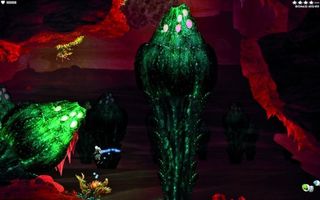Our Verdict
A calming, likeable adventure with an engaging premise, but Waking Marss roots could go a little deeper.
PC Gamer's got your back
Waking Mars is not a game about gardening. True, your primary interaction with the world is to fly around 2D caves gathering seeds, throwing them in patches of fertile land, then watering and feeding them compost. So far, so Titchmarsh with a jetpack.
At some point though, after the slightly-too-long intro phase, you realise that Waking Mars is actually about ecosystems: organic machines running autonomously, and the satisfaction of knowing that it was you who built the engine.
Functionally it's an adventure game. You're Liang, an astrobiologist who discovers life in an ancient Martian cave network. Dour and serious, Liang has a support team consisting of the upbeat Armani, and ART, the 'wacky' AI. Think pedantic Claptrap. Yes, that bad.

ART's incessant chattering aside, Liang's task is mostly a solitary one. He must explore the cave and make observations about the plants and animals he finds. Each has a checklist of behaviours to discover: how they reproduce, their predators, their defence mechanisms. But separating Liang from the bulk of his research are 'cerebranes': alien membranes that block your progress until you raise a chamber's biomass.
This means bringing the dormant networks to life. Everything you plant has a biomass value, but you'll need a mix to hit the highest levels. The standard plant is the seed-spitting halid. First, though, their ground must be watered, using collectible liquid orbs produced by hydra plants. Animal-like creatures, such as the skittish phyta, will then feed on scattered halid seeds to asexually reproduce.
In the later, larger caverns, the workings of these interconnected species can produce a beautiful clockwork display. Phyta chase halid seeds, prax (a sort of aggressive venus flytrap) feed on phyta, generating their own seeds to be collected in turn. Plants beget animals, animals beget plants. At times I was happy to sit back and watch its self-sustaining, hypnotic rhythm.

The downside to this is that, once you've seen one open room at full biomass, the game's only response is to get larger. Working out how to maximise a chamber is a trick you only need to learn once, at which point the game becomes more about the busywork of doing rather than the thrill of discovering.
Themed areas sometimes hold clever interactions to spread life, but they're rarely challenging as much as passively interesting. Waking Mars peaks around its second third, at which point it settles into the more sedate experience of travelling around, collecting the materials and shepherding the animals to cultivate each new room. It's enjoyable to the end, but the focus shifts into the relaxing and sedate pursuit of perfection and the tactile pleasure of manipulating the environment.
I guess it is a game about gardening after all.

◆ Expect to pay: $11 / £7
◆ Release: Out now
◆ Developer: Tiger Style
◆ Publisher: In-house
◆ Multiplayer: None
◆ Link: www.bit.ly/RTVqBs
A calming, likeable adventure with an engaging premise, but Waking Marss roots could go a little deeper.

Phil has been writing for PC Gamer for nearly a decade, starting out as a freelance writer covering everything from free games to MMOs. He eventually joined full-time as a news writer, before moving to the magazine to review immersive sims, RPGs and Hitman games. Now he leads PC Gamer's UK team, but still sometimes finds the time to write about his ongoing obsessions with Destiny 2, GTA Online and Apex Legends. When he's not levelling up battle passes, he's checking out the latest tactics game or dipping back into Guild Wars 2. He's largely responsible for the whole Tub Geralt thing, but still isn't sorry.

